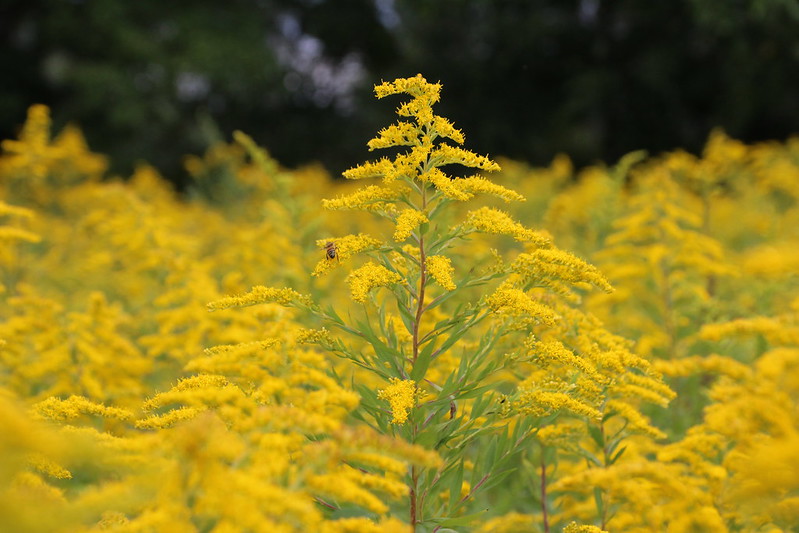As summer begins to wane, Goldenrod lights up fields, meadows, and gardens with its bright, golden spires. Often misunderstood as a cause of seasonal allergies (a reputation that rightly belongs to ragweed), goldenrod is in fact a valuable pollinator plant that adds energy and movement to the garden when many other blooms have faded.
This tough native wildflower is drought-tolerant, easy to grow, and incredibly attractive to bees, butterflies, and other beneficial insects. Whether planted in naturalistic groupings or mixed borders, goldenrod brings an effortless, late-season charm.

Portrait of the Goldenrod
Goldenrod belongs to the Asteraceae family and is native to North America. It includes over 100 species, but many cultivars have been developed for garden use with tidier habits and less aggressive spreading.
While some species are aggressive spreaders, newer garden varieties like Solidago rugosa ‘Fireworks’ or Solidago sphacelata ‘Golden Fleece’ are compact and well-behaved, ideal for mixed perennial beds.
Foliage and Form
Goldenrod typically forms upright clumps with lance-shaped green leaves and tall stems that bear arching or plume-like inflorescences.
- Height: 60–150 cm (2–5 ft) depending on variety
- Spread: 30–90 cm (1–3 ft)
- Form: Erect, clumping or spreading depending on species
Blooms and Fragrance
The flowers are tiny but grouped in showy panicles or clusters, creating a brilliant yellow effect that catches light beautifully in the garden.
- Bloom Time: Late summer to early fall
- Color: Bright golden yellow
- Fragrance: Mild, some species have sweet-scented blooms
The Right Time to Plant and Care for Goldenrod
Goldenrod is best planted in spring or early fall. It requires little pruning, though you can cut it back in early summer for a bushier form, and again in late fall after blooming has ended.
| Month | Planting | Flowering | Pruning |
|---|---|---|---|
| January | ❌ | ❌ | ❌ |
| February | ❌ | ❌ | ❌ |
| March | ✅ (start indoors or divide clumps) | ❌ | ✅ (cut back old stems) |
| April | ✅ | ❌ | ✅ (early pinch to reduce height) |
| May | ✅ | ❌ | ❌ |
| June | ✅ | ❌ | ✅ (optional pinch back) |
| July | ❌ | ✅ (start) | ❌ |
| August | ❌ | ✅ | ✅ (deadhead if desired) |
| September | ✅ (in mild climates) | ✅ | ✅ |
| October | ✅ | ✅ (late bloom) | ✅ (cut back after frost) |
| November | ❌ | ❌ | ✅ |
| December | ❌ | ❌ | ❌ |
✅ = Recommended ❌ = Not advised
Watering, Sunlight, Indoor vs Outdoor, and Temperature
Watering
Goldenrod is drought-tolerant once established but appreciates occasional watering during prolonged dry spells.
- Water young plants regularly.
- Mature plants can handle dry soil but perform best with consistent moisture.
Sunlight
Goldenrod thrives in full sun and will bloom most vigorously with at least 6 hours of direct light daily.
- Can tolerate partial shade but may flop without enough sunlight.
- More compact varieties handle shade better.
Indoor vs Outdoor
This is an outdoor perennial suited for borders, meadows, and pollinator gardens.
- Not suited to indoor growing.
- Best established in well-drained garden beds or prairie-style settings.
Temperature
- Hardiness: USDA Zones 3–9
- Ideal Range: 15–27°C (60–80°F)
- Frost Tolerance: Dies back in winter but returns from roots in spring
Ideal Soil Conditions for Growing Goldenrod
| Soil Feature | Optimal Condition | Why It Matters |
|---|---|---|
| Soil Type | Loamy or sandy | Supports drainage and root health |
| Texture | Light, well-structured | Prevents compaction and root rot |
| Drainage | Well-draining | Goldenrod dislikes soggy roots |
| Moisture | Moderate to dry | Encourages hardiness and drought resistance |
| Soil pH | Slightly acidic to neutral (6.0–7.5) | Suitable for native species and general performance |
Common Problems & Solutions
| Issue 🐾 | Symptoms 🔍 | Solutions 🛠️ |
|---|---|---|
| Powdery Mildew 🌫️ | White patches on leaves | Space plants well; improve air flow |
| Flopping 🔄 | Tall stems bending over | Stake taller types or pinch in early summer |
| Leaf Spot 🟤 | Brown spots or yellowing | Avoid overhead watering; remove affected leaves |
| Aggressive Spread 🌱 | Taking over garden area | Choose clumping cultivars; divide regularly |
Tough, vibrant, and bursting with late-season color, Goldenrod deserves a second look in modern gardens. Its ecological value, low-maintenance nature, and resistance to deer and pests make it a standout perennial that pairs beautifully with asters, ornamental grasses, and native prairie plants.